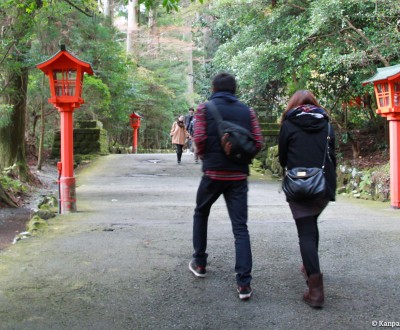Surviving Winter in Japan
Contrary to very hot and humid summers, winters in Japan are generally rigorous and chilling. Sometimes you'll have to not rely on temperatures indicated by the Japanese weather agency, because there are some major drawbacks that accentuate the cold in Japan:
- lack of insulation which creates a significant heat loss: no double glazing most of the time, even in recent apartments
- lack of central heating, but air conditioning is used both for heating and cooling in every living or bedroom
- penetrating cold winds that accentuate the impression of chilling, even when temperatures are positive
I spent several weeks traveling in Japan during winter, and we were outside to visit and explore most of the time. That's why it's possible for me to give a number of tips to better face the cold Japanese winter.
As japanese seasons are pretty well set, these tips will certainly be useful for trips that occur mainly in January and February, but it may include December and March, and probably more when visiting north of Japan such as Hokkaido.
Cover up
It goes without saying, but multiplying layers is obvious. Some materials can be used to keep warm, such as wool. As human body's ends lose more heat, gloves, scarves and hats are recommended. There's a wide range of accessories delivered by Japanese fashion to find something you'll like.
Uniqlo clothing chain has developed a self-heating technology for its winter range, called HeatTech. Use it as much as the "Dry" range during summer. For the lower body, sub-pants are recommended when it's too cold : leggings for girls and tights for boys.
Warm up outside
When we spend the day out to go visit, the body tends to cool down despite clothing layers. A quick way to warm up is to drink hot drinks regularly : tea, coffee, hot chocolates, soups... No need to prepare a Thermos and carry it all day long ; the big advantage of Japan is that countless ATMs or konbini sell heated cans for about a hundred yens. This warms hands at the same time !
Moreover, konbini sell several kinds of "heaters" :
- heating patches to be applied on the body, that last several hours (they are sometimes in 100 yen shops)
- kairo disposable heaters for outdoor use (to hold in your hands or slip into socks)
- reusable microwave heaters, for example to put in pillows
When cold is too penetrating, don't hesitate to take breaks indoors, for example to go shopping in heated shops or in museums. During lunch and dinner, you can spend a bit more time in restaurants, and at any time in cafes. Several dishes of Japanese cuisine will warm sustainably, especially nabe, but even ramen 🍜.
More durable, the sento or onsen ♨️ solution : traditional public baths and hot springs. Set aside your modesty and go spend several hours in hot water, you won't regret it ! And if you are extremely shy, there's always the solution of private onsen.
Some Japanese also use masks 😷 to avoid breathing too cold air. Finally, don't forget your lipstick and your moisturizer, especially for the hands and face.
Inside Japanese apartments and houses
If you live in Japan or stay in a Japanese house, once again local solutions are available.
One of the most traditional is kotatsu, the heating low table on which is placed a duvet. It's less common in modern houses, but it has proven a long time! The Japanese don't really turn it off at night, so it's a good idea is to drag your clothes under the table during the night! Kotatsu can be found at Muji or Loft for about 10,000 yen 💴.
If your living room doesn't have air conditioning, you can invest in a tôyu : an extra propane heating. It can be easily found for about 80,000 yen (plus 100 yen per liter in gas stations when buying large cans) and heating efficiency has almost no equal, but you'll have to support a strong smell.
The Japanese often shut off the heat at night to save up. In return, they often pour hot water in their bath a few minutes before undressing in the bathroom 🛁. Not very green but quite effective. In any case, you can enjoy a hot bath to raise the body temperature.


